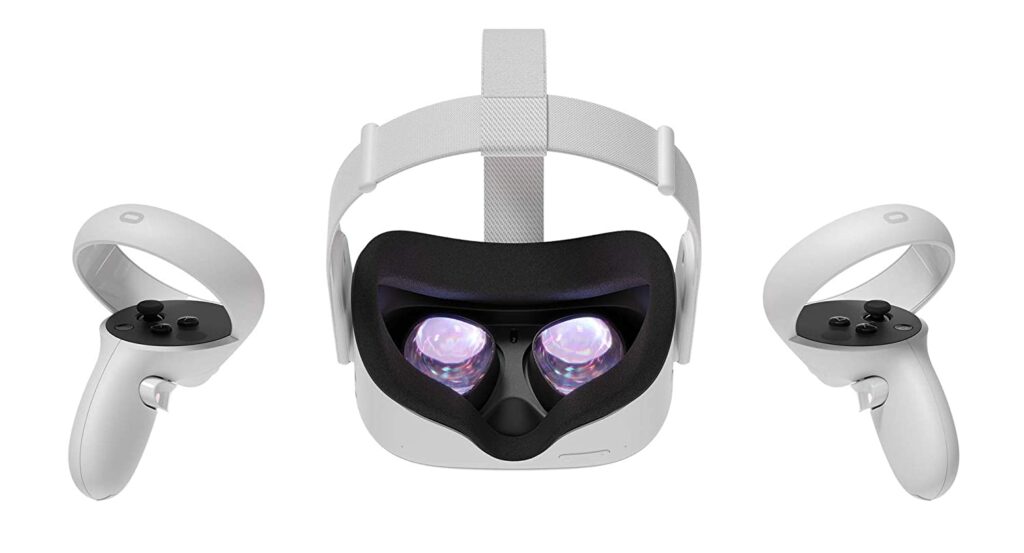- Best Pokemon VR Games - August 15, 2022
- Beat It!: Best Custom Beat Saber Songs - August 4, 2022
- Best VR Steering Wheels Guide - June 6, 2022
If you’re a VR gamer or enthusiast looking to buy an Oculus Quest 2 headset but cannot decide on the storage option, you want to get out of the Oculus Quest 2 64 GB and the Oculus Quest 2 256 GB, this is the article for you.
I will explore what the key differences are between the 64 and 256 GB options, their pros and cons, as well as my views on which version would suit what type of user.
Introduction
The Oculus Quest 2 is the flagship VR headset from the company. While the headset itself accounts for no slots for expandable memory, it comes in three internal storage options.
You may wonder why these storage options are different. This is because some users are likely to keep the whole library of playable games loaded on the device at all times, while some users (like myself) prefer to cycle through games.
If you’re looking to enter the VR space with this headset, or looking to upgrade from an older model of headset, this article will offer some insight into how much storage it is you really need, for the way that you plan to use the headset.
At the outset, it is obvious to state that there are price differences between all the different storage options of the headset. The difference between the headsets is a $100 price point for every upgrade in storage. Here, it’s easy to recommend that if you won’t miss the extra 100 or can afford to shell out the extra money, it is more advisable to spend the extra money to get the larger storage option, just to be safe.
I’ve looked into the differences between the options and how you, as a buyer, would need to go about thinking of buying an Oculus Quest 2 headset, and I will discuss my recommendations and experiences in the comparisons and subsequent sections below.
Bottom Line Up Front
There’s a ton of stuff to do with the Oculus Quest 2 headset, including but not limited to standalone VR gaming, tethered VR gaming, media consumption, and interactive features. All of the specifications on the different storage options on the headset are the same, except for the storage options.
The 64GB option is meant for gamers that don’t want to keep too many games on their device. If you’re a more casual or entry-level gamer, then this option may be something you can consider.
The average game on the library of the VR headset comes up to about 3-4 GB as of now for the more intensive and interactive titles. If you’re going to use the headset as a standalone Virtual Reality device and don’t plan to install too many titles on it, the 64GB option is likely going to be more than enough for you. At least in the short run.
However, it is pertinent to note that in the long run, as developers start to draw the most out of the headset, the size of games and applications will increase and the storage option at the lowest end may not end up being enough a few years down the line, as you load more games on to it.
That being said, the company has made the lowest end storage option with the users in mind, and by no means will this fall short of how much space you need to play most VR titles. In the long run, this may mean that you need to pull the old PlayStation maneuver and uninstall games as you’re done with them, in order to install new ones. However, unless you plan on having a sentimental attachment with games, this is an option I strongly recommend.
Contrastingly, the Oculus Quest 2 256GB headset is meant for more intensive users. If you plan to keep the gaming titles from your headset loaded and ready for a long time, or plan on using it for tethered gaming a lot, or just want the extra space to be safe, this storage option is more friendly for you. In fact, it’s naturally safer to have a larger storage option if you can, since it’s not going to hurt to have the extra space available.
If you don’t need it, you don’t have to use it. Knowing you have it in case you do need it, gives a good sense of security to the intermediate-experienced VR user in the long term.
Key Differences between the Oculus Quest 2 64GB and the Oculus Quest 2 256GB
Hold on to your seat. This one is going to be a shocker! The main difference between the two variants of the Oculus Quest 2 is, (you guessed it), storage. The headsets are completely identical in every way, including software, hardware, specifications, and internals. The only difference is in the storage. Oculus has given no extra features, battery, or hardware to the higher storage option.
The Oculus Quest 2 64GB

Meant mostly for the casual or light gamer, the Oculus Quest 2 64GB is enough storage space to play your heart out in VR. With the average game coming in at around 2-3GB as of now, 64GB storage as an option will offer ample space to install and play current VR gaming titles and storing them for extended periods of time before you have to even consider an uninstallation. This will also leave enough space for non-gaming apps, for interactive media, or even music.
The headset’s actual storage space comes down to 50GB when you account for the pre-installed apps and the software onboard.
The storage option is also safe, if you manage your storage correctly. Not all VR games are designed to be played regularly and some heavily story mode driven games such as Moss, Star Wars: Vader Immortal and other such games don’t need to stay on your headset after you’ve completed the campaign. The only games you’d want to keep on indefinitely are endless Quest games or RPG format ones that would provide a virtually infinite amount of playtime.
You could arguably put about 30 games on the Oculus Quest 2 64GB at one point of time if you manage the storage well, and the gaming titles you install are in the ballpark of about 1-2GB a game. Then again, some of the more serious titles like The Walking Dead and Resident Evil come in at 7 and 8GB, respectively. If you plan on playing multiple such titles, this storage variant might not be the one to go for.
If you don’t play too many gaming titles because of a shortage of time, enthusiasm or just a lack of that level of interest in the VR space, you can consider the Oculus Quest 2 64GB option as a great entry-level device into the VR space. Managing media stored on the VR headset is another way you can convince yourself to purchase the cheaper option.
A movie stored on the headset can take anywhere from 2 to 8GB depending on quality and size. Deleting these after having viewed them will save you a good amount of space. Currently, movie downloads are a thing of the past with OTT streaming services being the preferred mode of media consumption now. So, if you plan only to install the likes of Prime, Netflix, Hulu etc., you will have more than enough space at your disposal as most of these applications come in at around 100MB per app.
If you don’t want even the streaming apps to take up space, you can just try and stream media directly from the PC to your VR headset. The bandwidth requirement is much less than using an Air Link for gaming. You can use an app like Virtual Desktop to stream from your PC to your headset, if you want to save up on that extra bit of storage.
Naturally, at the small storage option, the minimum entry price of $300 is what makes it an enticing option if you need to enter the VR space and are on a budget. The only downside of having the headset is that the games will improve on the Oculus systems as developers put in more features and make better games, which means the storage space of the average VR game will go up.
In the long-term, this headset may cause storage issues if you want to keep putting flagship VR gaming titles on your headset without having to worry about deleting them. The lack of expandable storage on the Oculus Quest 2 64GB is also another downside of getting the lower0end of storage for your headset. There are no slots for Micro SD Cards or any other such expandable storage on any of the Oculus Quest headsets. Imagine buying a 64GB iPhone X in 2018.
It’s great as a device and works exceptionally. In a couple of years, however, the average storage space taken up by apps goes up, there’s a bunch of apps on your phone that you cannot delete and over the course of time, your photos, videos, applications, backups, and files take up that 64GB to a point where deleting some things is the only option left, lest you be greeted by the dreaded “iPhone Storage Full” notification.
Another downside of the 64GB model is its availability. It’s been taken out of the line-up by Oculus, who have now upgraded the bottom-level storage to 128GB at the same price point. This is the obvious alternative to getting the Oculus Quest 2 64GB.
The Oculus Quest 2 256GB

The big one. An option that is incredibly easy to recommend should you have the bandwidth to buy it and use it to its full potential. Meant for the serious VR gamer, media enthusiast and player.
If you plan on playing extensively and keeping your VR titles on your headset, then the Oculus 2 256GB option can easily fulfil your needs. It’s like getting that 1TB storage option on a Smartphone. Chances are you won’t notice it’s filling up, and when you do start to notice, it’ll still have enough leeway to not make you anxious about storage space.
Even with game developers releasing the above-mentioned titles that come in at upwards of 5GB, you’ll have plenty of storage to play around with even after installing a bunch of games.
This headset is an instant recommendation from me if it’s in your budget. It’s easy to see the benefits since you can keep putting games on hold and move on to new titles. You can also store any media on there without worrying about filling the device up. It’s the headset that I’d recommend personally to any buyers looking to enter the VR space, be it a casual gamer or experienced VR gamer.
The reason I’m so enthusiastic about the larger storage option is the longevity that it promises. With developments, device age, new apps, and new VR experiences coming in, you can bet it will last you the entire time without any hiccups. It’s great to have the extra space going into your second, third, or even fourth year of VR use with the same headset.
The only downside I can imagine for the headset is, unfortunately, the $400 price point. Of course, my opinion still is that it’s meant to be a long-term device and using it for years on end means you’d be safer spending extra money now. It’s better to be on the safer side of storage rather than saving a hundred dollars and buying the 64GB option and then regretting it later on, if your VR experience is enjoyable, and you become a more frequent user.
Alternatives
The only alternative has already been talked about. The Oculus Quest 2 128GB option is the way to go as a primary alternative. It’s the only headset that has the VR game library specific to the Oculus Quest series. It can also run the Rift store games through tethering via a Link Cable or Air Link. Since you’re reading this article to decide on an Oculus Quest 2 headset specifically, this is the only correct alternative I can suggest.
The Vale Index System and PlayStation VR Headset are both good alternatives as VR headsets in their own right. However, both of them run different game libraries, so they would not work as true alternatives to the Quest 2 headsets, and I cannot suggest them in this piece in good faith.
Frequently Asked Questions
Question: Are the Technical Specifications Different on the Oculus Quest 2 64GB and the Oculus Quest 2 256GB?
Answer: Nope! Everything is the same there. Both of the storage options come in with the exact same tech specs and the same internals and externals. Oculus made sure you get exactly the same features and experience with both options, so if you’ve zeroed in on the Oculus Quest 2, this is the only purchase decision you’re facing.
Question: Is Cloud Storage an Option on the Oculus Quest 2 VR Headset?
Answer: Absolutely! Cloud storage is available on all Oculus Quest 2 headsets. If this is a feasible storage option for you, you can consider the Oculus Quest 2 64GB and manage the space with the help of the cloud. This could help you make a cheaper purchase if you don’t really need all of the extra storage from the Oculus Quest 2 256GB.
Question: Is the Oculus Quest 2 64GB Discounted After the Oculus Quest 2 128GB was Released?
Answer: Unfortunately, not. It was released at the exact same price point as the 64GB variant. The 64GB variant has been removed from the line-up from Oculus’ website officially. However, you can likely find one cheaper than the 128GB option at a retailer like GameStop or BestBuy depending on availability.

Conclusion
The Oculus Quest 2 headsets come in different storage options. These are the Oculus Quest 2 64GB, the Oculus Quest 2 256GB and the newly added Oculus Quest 2 128GB. In this article I compared the Oculus Quest 2 64GB and the Oculus Quest 2 256Gb.
There are no differences between the two headsets except for the storage space options. If this Oculus Quest 2 series is the one that you’ve narrowed down as the type of headset you want, then the storage options are the only thing you have left to choose.
While the 64GB version is great for casual gamers and light users in the VR space, it may fall flat in the course of the long-term goal. If you plan on using the headset for the coming 3 years or more, the increasing game and software sizes including updates and new games will mean that the 64GB option will fall a little short. It comes in at a $300 price point, meaning it is an enticing option for anyone who isn’t very invested in using the VR space for heavy gaming or regular use.
For entry-level gaming and media consumption, this is an easy option to suggest, keeping in mind the storage sizes increasing for every app and game over time.
The Oculus Quest 2 256GB option is what I personally suggest to all users that can shell out that extra hundred dollars. It comes in at $400 but the ample storage space ensures you don’t have to worry about space management and uninstalling games or apps. It will comfortably take you through the near future without you ever having to worry about when you may run out of storage. In the next four years, it would be difficult for any entry-level or casual to light gamers to fill up the storage space in the headset.
The longevity this headset promises is definitely my favorite part of the storage option. If you ignore the price point for a second, you’ll see that it’s a no-brainer for a long-term purchase.
The alternative to these two storage options is the newly added Oculus Quest 128GB which Oculus has used to replace the 64GB model on the line-up on its website. This is where they want the buyers to put their money. If you’re stuck in the middle between the two headsets this article talks about, this storage options is, well, in the middle. So, you’d be better off buying this if you’re closer to an experienced-intermediate level VR gamer.
Whatever you do choose, remember that storage management isn’t the end of the world, and it is doable for 64GB users as well. If you want the headset, go for it because the features, library, hardware, and developments to the headset are some of the best in the VR industry, with the Oculus systems being arguably one of the most user-friendly and enjoyable VR interactions.
Happy shopping!
Continue reading:


